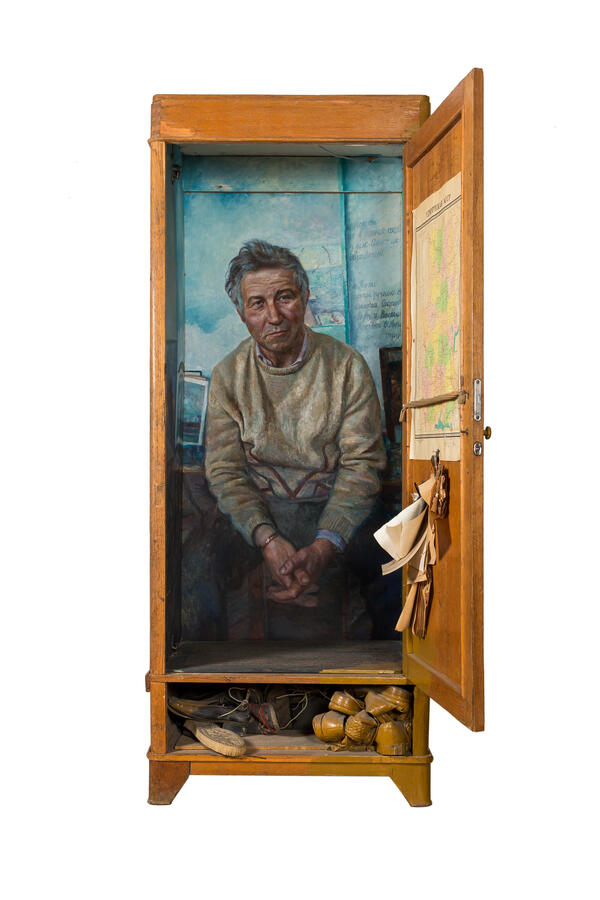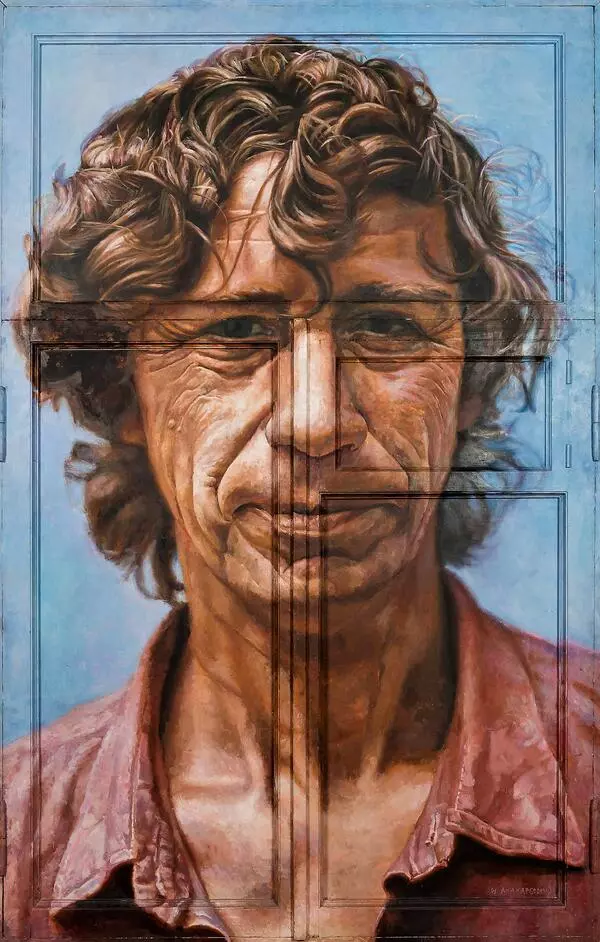The exhibition presents the work of Igor Makarevich, one of the leading representatives of the Moscow Conceptualist School. Since the late 1970s, he was a member of the group “Collective Action”, which arranged field performances — “Trips Out of the City”. The organizers often invited random people who were not part of the group and did not know about the purpose of the trip. These people completely unexpectedly found themselves inside a strange performance and only then realized that they had become participants in an artistic action.
In the 1990s, Makarevich began to work together with the artist Elena Elagina.
In many projects, Makarevich develops the theme of artistic mystification, which is important for Moscow Conceptualism. The installation “Ilya’s Wardrobe” is a good example illustrating this topic. Makarevich portrayed one of his friends, Ilya Kabakov, inside a wardrobe that looks like a sarcophagus, thereby canonizing the artist’s personality and features characteristic of his work.
Ilya Kabakov is one of the most popular Soviet artists in the West. Like Igor Makarevich, he adheres to the style of Moscow conceptualism. The artist became world famous after his immigration to America thanks to his installations in which he explored Soviet everyday life.
In the 1960s, Kabakov was an active participant in dissident art exhibitions in the Soviet Union and abroad. However, he himself later refused to consider himself a dissident artist. During a trip to the United States in the late 1980s, Kabakov said in an interview for the English-language collection “Soviet Dissident Artists”: “I was not a dissident. I did not fight with anyone or anything. This term does not apply to me.”
In the 1980s, he became less involved in graphics and focused on installations in which he used common trash and evoked the life of communal apartments. When interviewed, Kabakov repeatedly said that the only way to avoid the destruction of his own personality in everyday conflicts with neighbors in a communal apartment was to escape to his inner world, where witty comparisons made it possible to laugh at the terrible conditions.
Two of Kabakov’s installations dedicated to communal life became especially famous. The first is called “The Man Who Flew Into Space From His Apartment” (1982). The man, who flew out of his apartment through a hole in the ceiling, on the one hand, embodied the Soviet dream of conquering space, and on the other, escaped the humiliating existence in a communal apartment. The second work is called “Toilet” (1992). It features a cozy Soviet living room in the same room with a public toilet.
In the 1990s, Makarevich began to work together with the artist Elena Elagina.
In many projects, Makarevich develops the theme of artistic mystification, which is important for Moscow Conceptualism. The installation “Ilya’s Wardrobe” is a good example illustrating this topic. Makarevich portrayed one of his friends, Ilya Kabakov, inside a wardrobe that looks like a sarcophagus, thereby canonizing the artist’s personality and features characteristic of his work.
Ilya Kabakov is one of the most popular Soviet artists in the West. Like Igor Makarevich, he adheres to the style of Moscow conceptualism. The artist became world famous after his immigration to America thanks to his installations in which he explored Soviet everyday life.
In the 1960s, Kabakov was an active participant in dissident art exhibitions in the Soviet Union and abroad. However, he himself later refused to consider himself a dissident artist. During a trip to the United States in the late 1980s, Kabakov said in an interview for the English-language collection “Soviet Dissident Artists”: “I was not a dissident. I did not fight with anyone or anything. This term does not apply to me.”
In the 1980s, he became less involved in graphics and focused on installations in which he used common trash and evoked the life of communal apartments. When interviewed, Kabakov repeatedly said that the only way to avoid the destruction of his own personality in everyday conflicts with neighbors in a communal apartment was to escape to his inner world, where witty comparisons made it possible to laugh at the terrible conditions.
Two of Kabakov’s installations dedicated to communal life became especially famous. The first is called “The Man Who Flew Into Space From His Apartment” (1982). The man, who flew out of his apartment through a hole in the ceiling, on the one hand, embodied the Soviet dream of conquering space, and on the other, escaped the humiliating existence in a communal apartment. The second work is called “Toilet” (1992). It features a cozy Soviet living room in the same room with a public toilet.




